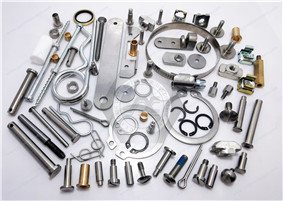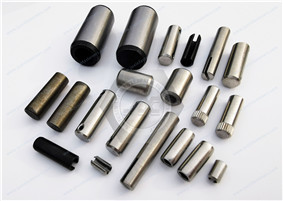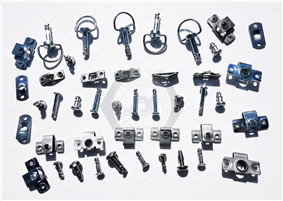Call Us
+86 136 6007 9809
Call Us
+86 136 6007 9809
Aug. 16, 2023
A locking pin is a standard fastener; its working principle is through the spiral movement of the thread embedded in the nut or threaded hole to tighten the connection. In engineering design and manufacturing, locking pins are widely used in various mechanical equipment and structures and play a role in fixing, connecting, and anti-loosening.
The working principle of locking pins can be divided into two steps: firstly, by rotating the locking pins, the threads will be nested with the threads of the nut or threaded hole; secondly, through the friction and preload of the threads, the locking pins and the nut or threaded hole can achieve a tight connection between the nut or threaded hole.
Specifically, the working principle of locking pin is as follows:
1. Threaded fit: The locking pin usually has external threads, which match the nut's or threaded hole's internal threads. By rotating the locking pin, its threads are nested with the nut's or threaded hole threads to achieve the connection.
2. Friction: There is a certain amount of friction between the locking pin threads and the nut or threaded hole threads. When the locking pin is rotated, the threads' friction prevents it from moving, thus securing it in the nut or threaded hole.
3. Preload: After rotating the locking pin into place, a certain amount of torque is applied to create a certain amount of preload between the locking pin and the nut or threaded hole. The preload force improves the tightness and stability of the connection and prevents loosening.
The following example illustrates the principle of operation of the locking pin: Suppose there is a nut and a locking pin; the locking pin has an external thread, and the nut has a corresponding internal thread. Firstly, the locking pin is inserted into the nut and rotated so both threads are nested. Then, the locking pin is turned into place by applying torque to secure it in the nut. The thread friction and preload between the locking pin and the nut will maintain the stability and tightness of the connection. The working principle of locking pins has a wide range of practical applications. For example, in automotive manufacturing, locking pins secure the connection between the engine and the chassis, ensuring stability and safety. Locking pins connect various components in mechanical equipment and engineering structures to ensure regular operation and use. Locking pins are standard fasteners that make tight connections by embedding threads into nuts or threaded holes through a spiral motion. The principle of operation includes thread fit, friction, and preload. The working principle of locking pins plays an essential role in engineering design and manufacturing to ensure the stability and safety of the connection. By understanding the working principle of locking pins, we can better apply and select suitable fasteners to improve the performance and reliability of mechanical equipment and structures.
 |  |  |
The pin is a class of standardized fasteners, both static and fixed connections, which can also be connected with the relative movement of the connected parts. It is mainly used for two parts of the articulation, constituting a hinge connection. The pin is usually locked with a cotter pin, which is reliable and easy to disassemble. The international standard for pins is ISO 2341:1986.
Common materials for pins: No. 45 steel, 40Cr, 30CrMnTi, 35CrMnSi.
1.45 steel is a commonly used material for shaft parts; it is cheap after tempering (or normalizing), can get better cutting performance, and can reach high strength, toughness, and other comprehensive mechanical properties, quenched surface hardness of up to 45 ~ 52HRC. 40Cr and other alloy structural steel are suitable for medium precision and high-speed shaft parts; after tempering and satisfying, this type of steel has better comprehensive Mechanical properties. No. 45 steel is widely used in machinery manufacturing and has excellent mechanical properties. But this is a kind of medium carbon steel; quenching performance is not good; 45 # steel can be quenched to HRC42 ~ 46. So if you need surface hardness but also want to play 45 # steel, it has superior mechanical properties, often 45 # steel surface quenching (high-frequency or direct quenching), so you can get the surface hardness needed.
2.40Cr is a commonly used material for shaft parts. It is cheap after tempering (or normalizing), and you can get a better cutting performance. It also gets high strength, toughness, and other comprehensive mechanical properties, quenched surface hardness of up to 45 ~ 52HRC. 40Cr and other alloy structural steels are suitable for medium precision and high-speed shaft parts; after tempering and satisfying, this type of steel has better comprehensive mechanical properties. 40Cr and another alloy structural steel is suitable for medium precision and high-speed shaft parts; this type of steel, by tempering and quenching, with a better comprehensive 40Cr is the standard steel number of GB in China, 40Cr steel is one of the most widely used steel in the machinery manufacturing industry. After tempering treatment, it has good comprehensive mechanical properties, good low-temperature impact toughness, and low-notch sensitivity; steel hardenability is good; water quenching can be quenched to Ф28 ~ 60mm, and oil quenching can be satisfied to Ф15 ~ 40mm. In addition to tempering treatment, it is also suitable for cyanide and high-frequency quenching treatment. Cutting performance is good when the hardness of HB174 ~ 229 and the relative cutting machinability of 60%.
3.30CrMnTi than 20CrMnTi steel strength, hardenability, but slightly lower impact toughness. Mainly used as carburizing steel, carburizing can be quenched directly at a reduced temperature, with high bending strength and good wear resistance. It can be used after quenching low-temperature tempering or tempering, cutting, and machining medium. Used in the manufacture of tractor industry in the cross-section of the more significant heavy-duty carburized parts and the more giant force gears, gear shafts, worms, and so on.
4.35CrMnSi steel is a low-alloy ultra-high-strength steel, heat-treated with good overall mechanical properties, high strength, adequate toughness, hardenability, weldability, machining, and molding are good. Still, corrosion and oxidation resistance is low, and a low-temperature tempering or isothermal quenching is used. 35CrMnSi steel is a good hardenability material; the appropriate heat treatment can be obtained after strength, hardness, toughness, and fatigue strength. Better comprehensive mechanical properties can adapt to coal mining production's more complex working conditions.
Contact Us
Tel.:
+86 020 8621 0320
+86 020 3121 6067
Technical Support:
Navigation
SEND INQUIREY